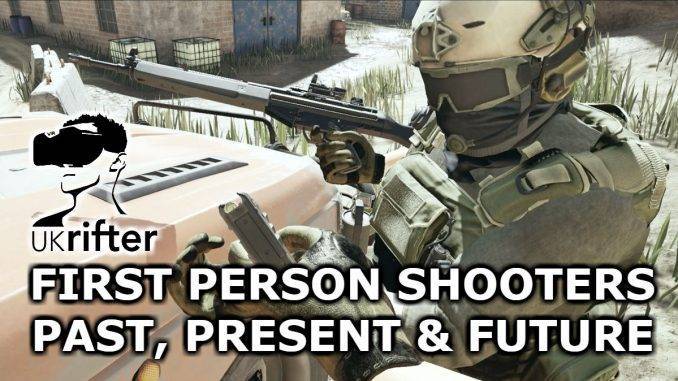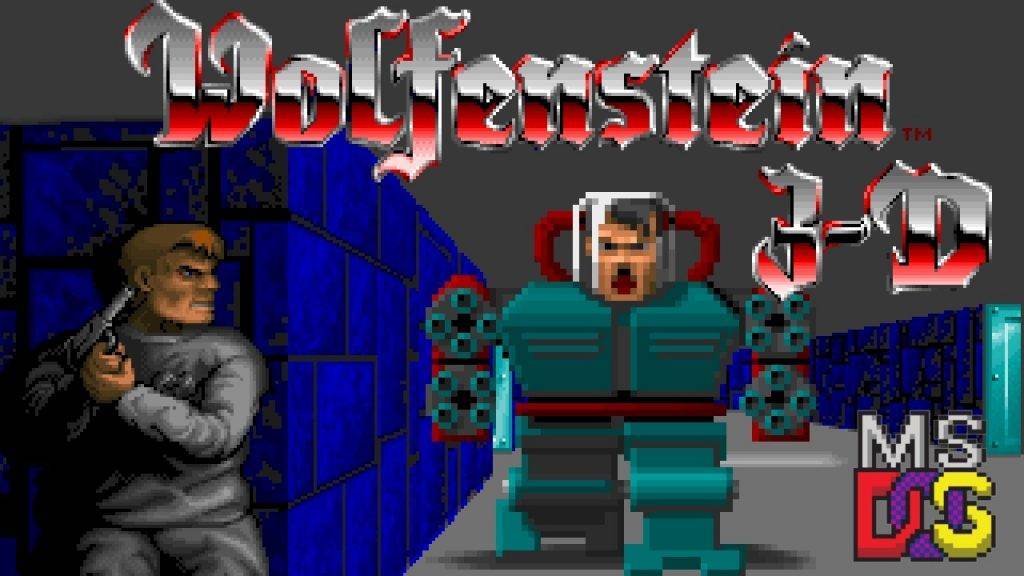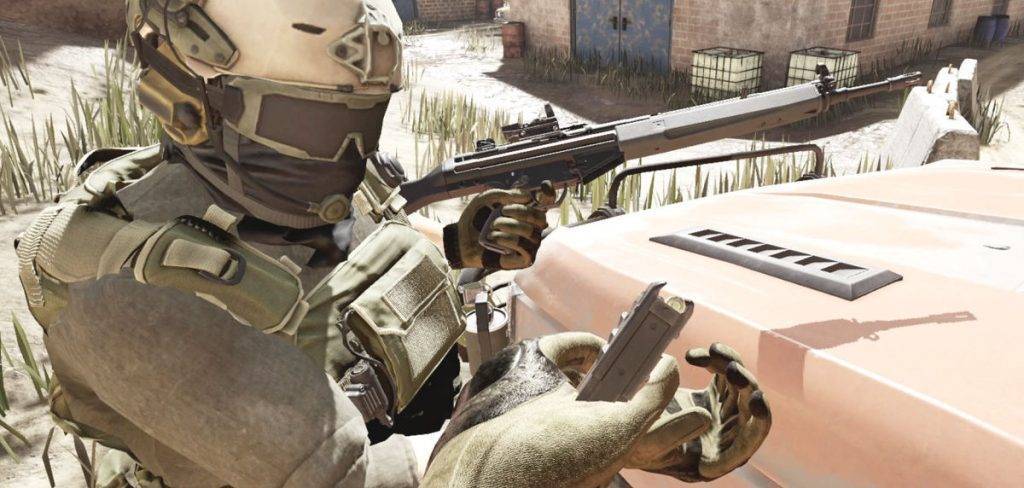
Humble Beginnings
First-Person Shooter (FPS) games have been a staple of the gaming community since Wolfenstein 3D (ID Software) exploded onto our screens with a spray of bloodied viscera back in 1992. Game developers were able to create 3D worlds for gamers to explore and, not unsurprisingly, hidden within those digital depths were horrors; monsters, robots, nazis! And in the case of Wolfenstein – Monster-robot-nazis. We grabbed our digital weaponry and started shooting with a natural desire to destroy the enemy.

The advent of multiplayer quickly expanded the reach and appeal of the first-person shooter genre. Bringing in cult game series’ such as; Unreal Tournament, Counter-Strike & Battlefield. Finally players were allowed to team up to fight a common foe, digital assets or, more enjoyably, fellow humans. More recently, Battle Royale style titles – developed from the Japanese dystopian future shock novel and film of the same name – have dominated the MP FPS scene. The innovation continues, but while the graphical fidelity and subtle game modes develop, in reality the principles are the same, shooting at an enemy. With such raw and base motivation, the voices of concern have been shouting from the inception.

Genre Stigmatisation
The media have, on many occasions, decided that mass shootings could be attributed to the perpetrators “morbid fascination” in violent computer games. Infamously this started with the tragic events on April 20th 1999 at Columbine High School, where Eric Harris and Dylan Klebold murdered 12 students and a teacher. At that time Eric & Dylan – like many computer game obsessed teens – enjoyed playing popular games such as Doom & Quake. It is worth noting that prior to computer games “Video Nasties” were cited as the poison for young and easily influenced minds. The politics of gun ownership in America is outside of the scope of this article, but the irony of blaming a gun game obsession rather than the fascination and access to the physical guns was lost. The triggers for these tragic events are often incredibly complex with news media oversimplifying in order to present a more palatable story. An attempt to provide closure to the mourning public. The simplified narrative continues to this day and for this reason the stigma has been difficult to shift. The First-Person Shooter genre is often marginalised by game critics for fear of promoting a title that may be linked to the next shooting.

Enter Virtual Reality
Multiplayer First-Person Shooters were not an immediate fit for Virtual Reality. The reliance on tracked hand-controls meant a long and frustrating wait for all. When the Rift touch controllers and Vive wands arrived so did hundreds of wave-shooter titles. Wave-shooters remain the distant relation of the FPS family that nobody likes to mention at gatherings. Wave upon wave of enemy, gradually increasing in number and strength, the “Space Invaders” of FPS. In the Wave-Shooter genre there were a few gems, Raw Data, Space Pirate Trainer and the highly evolved Oculus touch launch title – Robo-Recall were a few examples of excellence. But these Wave-Shooters, while initially exciting, were a poor diet for the Virtual Reality consumer. Multiplayer FPS was yet to have it’s moment in VR and the community was thirsty.

That thirst was finally quenched with the launch of what are now seminal titles such as Stand Out, Onward & Pavlov, games that perfectly translated the MP FPS genre into the Virtual World. More and more titles were released, barely in pre-alpha state, to a demanding and frenzied community.
Initially the direct translation of existing flat-screen titles into the virtual world appeared unimaginative, games paid homage to (completely ripped off) the PubG, Fortnite & the Counter-Strike formats. But Virtual Reality added presence to a degree that was bordering on unnerving. The world of a First-Person Shooter became truly thrilling but ultimately a psychologically and emotionally exhausting place. The simple act of reloading a weapon taking skill and knowledge under extreme pressure, building of muscle memory over time, where once we just pressed the “r” key. Peripheral gun stocks adding yet more immersion in the role. The role of a killer.

The Future
While idly chatting with a friend in the metaverse, we discussed the amusing VR naysayers and their ignorant criticism of the technology, of course with the arrogant disdain that only a true addict can muster. It was during this conversation, laced with titters and scoffs, that we considered the humble FPS and how ripe it was for the critics and their click-bait concern. During this conversation dawned a stark realization, a thought that made the hairs on my neck stand up.
I knew how to use an AK-47.

Me, a middle-aged British man with no military training. I didn’t just know how to fire an AK. I knew every inch of that weapon; where the magazine catch was, how to unload and reload a clip, how to pull back the charging handle, switch the fire modes, I knew the names of the attachments, their advantages and disadvantages in battle, the ACOG, holo, silencer, red dot. But not just the AK-47, tens of weapons I knew with shocking familiarity and, I dare say, completely newfound appreciation.
I have been educated in the use of these weapons.
It was then I realised exactly what was coming. The inevitable, inescapable horror. Another search for reason by a mourning public. The obvious stigmatisation of Virtual Reality as a medium to corrupt. Perhaps this time the black mark will not be scrubbed away so easily. The new narrative surely more believable than a disturbed kid bewitched by the flickering lights on a monitor. A virtual training camp with impossible levels of immersion will be portrayed. The public will latch on to this new, improved, dangerous version of the old scapegoat. Nefarious activities played out by disturbed minds in a dark and hypnotic Virtual Reality, this story will make sense of the senseless. Studies will be conducted, differing conclusions drawn.
What is clear is that the use of Virtual Reality in business as a powerful, cheap, accessible and safe method of training is well understood and growing fast. Who is to say that these enterprises that wish to be trained will be flying the flag of western capitalism. A charming naivety exists within our Utopian community, we are so focused on the shining examples of Virtual Reality’s power for good that we gloss over or even completely ignore the equal – perhaps greater – potential for evil. If we do not acknowledge this concern, if we sleepwalk into this problem without at least an acknowledgement, then our community faces a more broad stigmatisation.

It is clear to me, that my own fascination with guns has grown directly because of my experiences in Virtual Reality FPS. So much so I am buying a target rifle and considering signing up with a local range, even looking into AirSoft gaming in my areas. This interest did not exist before. What does it mean? How does this translate and scale across millions of potential obsessives like me? Does it represent a problem? I am not alone, a friend in our community expressed the same observation.
… it made me really think. I was anti gun but since getting into VRFPS, I now have 2 gun stocks and play airsoft with a replica SCAR-L. I barely knew what a gun was and now I know A LOT.
From Twitter – Name Removed
I believe the FPS genre will continue to be beaten and battered, but will ultimately survive. The urge, the need to destroy enemies will always be strong. I for one hope that, after the dust settles, there is still room for First Person Shooters in our metaverse.
by Christopher Gray
aka – UKRifter
If you enjoyed this article then you may be interested in:
Joining my VR discord community – http://discord.ukrifter.com
Following me on Twitter – http://twitter.com/ukrift
Subscribing to my VR Youtube channel – http://youtube.com/theukrifter
Following me on Twitch – http://twitch.tv/ukrifter
